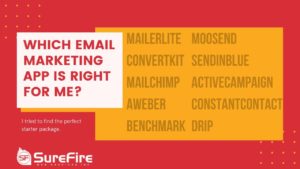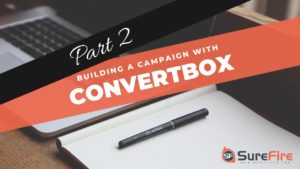People show their best side when on a job interview. They get a haircut, put on a suit or a dress, make sure their teeth are clean — they try to make a good impression.
Every time someone comes to your website home page, your business undergoes that “job interview.” People are there to see the details and to create an opinion of your business.
So– is your homepage making the right first impression?
The KISS Principle

´The ability to simplify means to eliminate the unnecessary so that the necessary may speak.´
This idea of simplicity was eloquently described by Hans Hofmann, an abstract expressionist painter, and it also applies to the design of a homepage. Otherwise known as the KISS (keep it simple stupid) principle. You want to make sure that you include everything needed…. nothing more. Visiting a new webpage is all about making a good first impression. Do the potential clients what to know more, or run away to another site with a better design? Here at SureFire Web services these are our top 15 must haves on your business homepage.
1. A Website
It’s 2018 and still, more than 40% of all small businesses don’t have a website even though customers expect them to have one. 36% of consumers state they are more likely to buy from a business that has a website than one that does not have any type of website.
2. Logical Design
Now that you know you need a website you need to think about design. Thinking about first impressions, you want to put your best foot forward so to speak. If the site looks like it’s out of the 90´s how can your potential client trust you to create something amazing for them when you can’t even do it for yourself? Often all you need is a clean and simple design.
Yes, you want it to look good, but most importantly, it needs to be useful and user-friendly. If it is overcrowded with content the potential client may become frustrated and leave to a site where they can find what they are looking for more easily. Google takes content and structure into account when ranking a site, so make sure the design and content have a logical flow.
3. Clear Business Direction
Think about what you NEED on the site versus what you WANT on the homepage. Tell your visitors exactly what it is you do in the simplest possible way. People tend to skim, so keep text in mission statements brief and to the point. What does your company do? Who does it do it for? How does it do it differently? Why should a guest read more and contact you instead of the competition?
Keep it simple and on target. As a business, you may need to include some supplementary information as well. For a restaurant, this would be locations and menu, for a web designer this would include links or screenshots of previous work.
4. Contact Information
Visitors should be able to find out how to contact your business quickly and easily. How many times have you wanted to call for delivery but could not find the phone number? Make your phone number, email, and mailing address visible and easy to find. If the prospective client cannot contact you they will move on to a company they can get ahold of without so much hassle. Try to include more than one method of contact and reply in a timely manner.
Speaking of design, this information should be found in the top menu or in the footer so as to be easily found. Perhaps put it in both places just to be sure that it can’t be missed. Another detail is to not have this information as an ´image´. It needs to be separate so it can be clicked on and copied.
5. A Map
One of the more recent and very useful features of web design is the ability to integrate maps into the content. Somewhere on your homepage you should integrate a Google map image to give readers an idea of how to get to your location
6. Easy Navigation
A website without clear navigation is useless. Place links to the most important aspects of your site in the top ´half´ of your page. This is just like a newspaper, keeping the important stories ´above the fold´. Few visitors will scroll down if they can’t find what they want in a few seconds at the top of the homepage. You want someone to arrive on your homepage for the first time and be able to know exactly where to proceed to find what they need without getting confused.
Items to include at the top of each page would be things like ´Home | About | Services | FAQ | Contact´ in addition to your company name and logo. Be consistent. If this is in the same place on both your primary and sub-pages it will be easy to spot as a visitor navigates your site.
7. Links to Social Media
Make it easy for people to follow your company on social media right from your homepage. By increasing your following on social media this also increases the odds that potential clients will click on your homepage on a semi-regular basis. This includes platforms like Twitter, Facebook, Tumbler, LinkedIn, Instagram, Youtube, and Pinterest. Include this information in your header or footer so it can be easily found. The more eyes on your content, the better chances you have of converting potential clients into clients. One important caveat is that you need to keep your content up to date and users engaged. There’s nothing worse than following a Facebook page that hasn’t been updated or added to in YEARS.
8. Meaningful Content
Your site might be GORGEOUS, but if you have no content then people won’t be sticking around for long. Include information that is helpful to prospective clients. Discuss your company, it’s features, it’s products, and the services offered. If there is a blog attached, keep the articles helpful and on topic. If your company has won any awards, mention it and brag a bit! This type of recognition adds credibility to your business and demonstrates that you are in fact an expert in your field.
9. Quality Images
Think carefully about what images you are using to sell your business. If the image is poor quality, low resolution, too small, or a stock image this will not engage your user or provide your company with credibility. Use uncluttered real photos of your company and team to paint an accurate picture of what the client will be receiving.
Photos need to be quality to appear professional, but they can’t be too high a resolution either. This will delay the loading of your page frustrating potential clients. Images should be compressed to around 72 dpi to be downloaded quickly but not so pixelated that your image quality decreases.
10. Client testimonials
Consumers trust reviews and testimonials, just as they would a friend’s recommendation. If you trust your service you could have a place for open reviews, or a specialized section where you capitalize on your current or previously satisfied clients. Ask them to write up what they liked about your business to provide more credibility to what you are doing.
11. Frequently Asked Questions
People have so many questions! If you find you´re being asked the same questions over and over again via phone, email, or social media start compiling a list. If those 10 potential clients have repeat questions, chances are more will feel the same. Provide a page to give clear and concise answers. These can be divided by category, for example, shipping, sizing, type of materials used, ingredients, cancellation policy, company history, services, or pricing depending on what type of business you specialize in.
12. Compatibility
Internet browsers: Maybe you work in Chrome or Firefox, but a potential client LOVES Explorer. How does your page appear and load for them? This needs to be taken into consideration so that your homepage can be effectively displayed in as many browsers as possible.
Computer types: While the majority of users are on PCs, there are also many individuals in creative fields that prefer to work on Macs. Pages do not always display the same, so think about your target audience and the compatibility before making your site live.
Mobile devices: Web design used to be just for computers, not it´s for anything with a screen and an internet connection. All of these have different screen sizes so responsive design is necessary to allow the page to adapt to the screen it´s being viewed upon. Why think about mobile use? Recent studies show that there is an increase in traffic coming from these sources and that there is a higher completion rate as well. Meaning that these individuals are more likely to end up as clients utilizing your services.
13. Call To Action
What do you want people to do when they arrive at your homepage? Do they subscribe to a mailing list? Email for a quote? Come to your physical store? Purchase a good or service? Call to speak with a manager? This goal should be clear and obvious for those arriving new to your site.
14. A Quick Page Load Time
Your page should load in two seconds or less. A slow website is bad for business. It keeps you from making sales and can hurt your rankings in the search results.
15. Statistics and Tracking
This aspect is not something that will be visible to guests on your homepage, but is nonetheless very important to your businesses development and growth. Areas to look at when tracking website statistics:
- How many hits does my site receive?
- How many of these are from unique visitors?
- How are people finding my website?
- What search terms are they finding me under?
- What websites link to me?
- What are the most popular pages on my site?
- Who is my average visitor (platform / browser / screen resolution)?
When you monitor who is coming to your page and how they are using it, you can then work to improve it!
Wrap It Up
Lastly, a quick note on what NOT to have. Remember to follow the KISS formula and keep it simple. You do not need to include, flash, anything that autoplays, extra information or media elements. All of these serve to distract, annoy, or delay downloading time.




